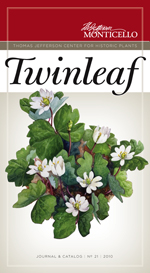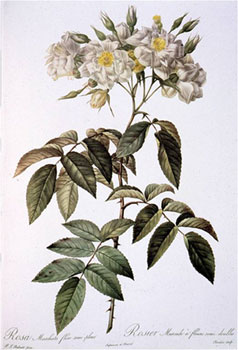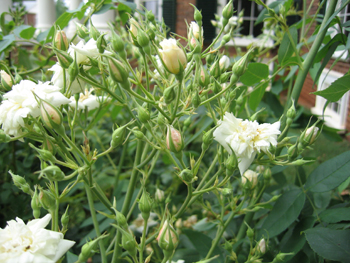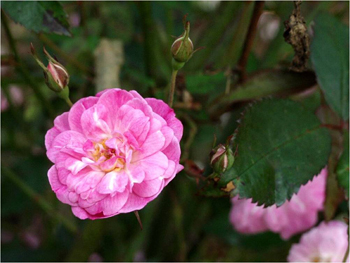
Thomas Jefferson lived through three revolutions in his life-time. Most of us know about two of them: our own nation's revolt against British domination, then the French uprising that brought down the monarchy just a few years later. Before his death in 1826, Mr. Jefferson would witness a third. It would again be a revolution with far-reaching effect; but this time it would be in the Rose garden and the world of horticulture would never be the same--I call this the China Revolution.
In the late 1700s on both sides of the Atlantic, the Rose was still the "Queen of Flowers" as the Greek poet Sappho had dubbed it in the sixth century BC. The mainstays of the garden were the very hardy types inherited from the Classical and Medieval worlds with lavish spring bloom and their attar-of-roses perfume. These European Old Roses (the Gallicas, Damasks, Albas, and Cabbage or Provence types) with their extraordinary but brief flowering season became the metaphor for evanescent beauty, here today and gone tomorrow, there were some exceptions. A few forms of Damask Rose could produce scattered bloom after the main spring flush. Nurserymen (with their flair for exaggeration) called them "Four Seasons" or "monthly" Roses. The Musk Rose (Rosa moschata) showed its sweet, starry white flowers summer and fall. However, the main beauty of the Rose garden was confined only to spring — that is until the 1790s when the revolution began.
 Throughout the 1700s Europe and its American colonies had an on-going love affair with anything Oriental. The craze began with silk and tea, and then extended to carpets, porcelain, and the decorative arts. Was it just an attraction for things that had come from so far away? Was it fascination for a style so different from heavier, more ornate European fashions? Through Chinese designs gardeners in the West developed an appreciation for tree peonies, chrysanthemums, and roses so different from their own flowers. By the mid-1790s several of these China roses (Rosa chinensis) had survived the eight to ten week voyage west. Many shipments had to be rested in British-controlled Calcutta mid-trip, leading to the mistaken impression in Europe that these plants were Indian. Thus many called these new roses "Bengals." Planted in the new climate, the Chinese roses initially were low-growing, smooth-stemmed, with shiny pointed leaflets. The flowers were few-petaled and only faintly fragrant compared to European roses. What made these Asian varieties revolutionary was their ability to bloom non-stop! As soon as the first petals drop, the plant sends out new laterals which terminate in more flower buds. In addition new shoots can arise from the plant's base carrying sizeable clusters of even more bloom. So determined were these Chinas to be ever-blooming that even newly-sprouted seedlings produce a bud with the third set of leaves! Amazing!
Throughout the 1700s Europe and its American colonies had an on-going love affair with anything Oriental. The craze began with silk and tea, and then extended to carpets, porcelain, and the decorative arts. Was it just an attraction for things that had come from so far away? Was it fascination for a style so different from heavier, more ornate European fashions? Through Chinese designs gardeners in the West developed an appreciation for tree peonies, chrysanthemums, and roses so different from their own flowers. By the mid-1790s several of these China roses (Rosa chinensis) had survived the eight to ten week voyage west. Many shipments had to be rested in British-controlled Calcutta mid-trip, leading to the mistaken impression in Europe that these plants were Indian. Thus many called these new roses "Bengals." Planted in the new climate, the Chinese roses initially were low-growing, smooth-stemmed, with shiny pointed leaflets. The flowers were few-petaled and only faintly fragrant compared to European roses. What made these Asian varieties revolutionary was their ability to bloom non-stop! As soon as the first petals drop, the plant sends out new laterals which terminate in more flower buds. In addition new shoots can arise from the plant's base carrying sizeable clusters of even more bloom. So determined were these Chinas to be ever-blooming that even newly-sprouted seedlings produce a bud with the third set of leaves! Amazing!
The first China Roses to be distributed were pink and red. The pink (today's 'Old Blush') was China's YUE YUE FEN ("Pink Monthly"), which shows up for the first time in silk paintings circa 1000 AD. Two reds had arrived around the same time: YUE YUE HONG ("Red Monthly") distributed by Gilbert Slater and CHI LONG HAN ZHU ("Pearl in Red Dragon's Mouth") which became 'Sanguinea' in early nineteenth-century horticulture. 'Old Blush' is hardy enough to survive most Zone 6 winters. A favorite in gardens, it is often found in cemeteries in the Middle Atlantic States and throughout the South. 'Sanguinea' is listed in catalogues today as 'Willmott's Crimson China' or by its Chinese name. This has become an heirloom plant in Afro-American gardens on the east coast of Florida. Graham Stuart Thomas has noted that: "these were the first truly red roses Europe and America had seen." "Red," up to the early nineteenth century had merely been rosy purple or even pink!
 The next ancestral Chinas to come to us were unlike previous introductions. Their petals were larger, the buds more scrolled, and their scent was curiously described as that of tea! L. Arthur Wyatt, British Rose authority explains, "The name derives from the resemblance of the two foundational members to the aromatic blends of Chinese tea which were drunk by the higher social orders in Regency times and were so expensive that they were kept away from the lower orders in locked caddies." Both of these "Tea-scented Chinas" or Tea Roses were procured in a Canton nursery with the able help of a young British tea inspector, John Reeves. First to bloom in the West was a blush variety, HSIAN SHU YUE CHI ("Fragrant Monthly Rose") which Reeves sent to Lady Amelia Hume in 1809 in a shipment of camellias. Its first flowering in James Colvill's Chelsea Nursery Rosa Redoutecaused a sensation. The newly-divorced empress of France, Josephine Beauharnais, very much desired plants of this for her great collection, so Napoleon arranged a truce with the British so the rose could get through. In her greenhouses at Malmaison this Chinese immigrant grew to perfection. Rose artist Pierre-Joseph Redoute`portrayed it as Rosa indica fragrans, possibly his most beautiful work. In 1823 John Reeves sent forty or so portraits of flowers available at Canton's Fa Tee Nursery to the Horticultural Society of London. Among these pictures was one of a Yellow Tea Rose. The Society, though short on funds, sent a young gardener; John Damper Parks, to personally escort the Yellow Tea and other treasures west. In 1824 he returned in triumph with sixteen new chrysanthemums, the first Aspidistra to be seen in Europe, the double yellow Rosa banksia, and the much-anticipated Yellow Tea Rose. Its Chinese name is closer to reality: DANHUANG XIANSHUI, "Light Yellow Sweet Water Rose." Botanists described it as OCHROLEUC ("yellow-white" in Greek) and FLAVESCENS ("yellowish"). The pale yellow petals turn ivory-white soon after opening. Yet yellow two hundred years ago was the rarest color on the Rose palette, so even a pale sister was very welcome.
The next ancestral Chinas to come to us were unlike previous introductions. Their petals were larger, the buds more scrolled, and their scent was curiously described as that of tea! L. Arthur Wyatt, British Rose authority explains, "The name derives from the resemblance of the two foundational members to the aromatic blends of Chinese tea which were drunk by the higher social orders in Regency times and were so expensive that they were kept away from the lower orders in locked caddies." Both of these "Tea-scented Chinas" or Tea Roses were procured in a Canton nursery with the able help of a young British tea inspector, John Reeves. First to bloom in the West was a blush variety, HSIAN SHU YUE CHI ("Fragrant Monthly Rose") which Reeves sent to Lady Amelia Hume in 1809 in a shipment of camellias. Its first flowering in James Colvill's Chelsea Nursery Rosa Redoutecaused a sensation. The newly-divorced empress of France, Josephine Beauharnais, very much desired plants of this for her great collection, so Napoleon arranged a truce with the British so the rose could get through. In her greenhouses at Malmaison this Chinese immigrant grew to perfection. Rose artist Pierre-Joseph Redoute`portrayed it as Rosa indica fragrans, possibly his most beautiful work. In 1823 John Reeves sent forty or so portraits of flowers available at Canton's Fa Tee Nursery to the Horticultural Society of London. Among these pictures was one of a Yellow Tea Rose. The Society, though short on funds, sent a young gardener; John Damper Parks, to personally escort the Yellow Tea and other treasures west. In 1824 he returned in triumph with sixteen new chrysanthemums, the first Aspidistra to be seen in Europe, the double yellow Rosa banksia, and the much-anticipated Yellow Tea Rose. Its Chinese name is closer to reality: DANHUANG XIANSHUI, "Light Yellow Sweet Water Rose." Botanists described it as OCHROLEUC ("yellow-white" in Greek) and FLAVESCENS ("yellowish"). The pale yellow petals turn ivory-white soon after opening. Yet yellow two hundred years ago was the rarest color on the Rose palette, so even a pale sister was very welcome.
 The impact of these Chinese imports can hardly be overestimated. Charlottesville landscape architect and Jefferson scholar C. Allan Brown has researched garden diaries in Charleston, South Carolina for the period 1790 to 1820. Horticulture in this important port city was transformed by roses that could flower through the heat and humidity of a Southern summer and still provide bouquets for the Christmas dinner table. The garden diary at Wyck in Philadelphia's Germantown was listing both the "Pink Daily Rose" and the Blush Tea by 1825, along with a profusion of Damasks and Gallicas. Nurseryman Robert Buist waxed poetic as he described the impact of the Chinas in 1847: "They have been -€¦ universally cultivated and are admired by all, Not only the cottager and the great, but the poor inmate of the most cheerless abode -€¦ all call this the favorite." Because of these Chinese imports, the average gardener wanted all his roses to be ever-blooming. Those varieties that bloomed in spring only were about to become permanently passé in all but the poorest and coldest gardens. Early nineteenth-century nurserymen began a hybridizing odyssey attempting to fuse the genes of the Chinas with hardier species. The journey would take them from the first Hybrid Chinas, through Noisettes and Bourbons, to the Hybrid Perpetuals, and then the Hybrid Teas. Breeders today may have attained the rosy version of the Holy Grail, (care-free, disease-free, ever-blooming, shapely bloom) with the introduction of 'Knock-out' and its kin. But for all the world, in my humble opinion, these newer kinds just look like the old China Rose — on steroids.
The impact of these Chinese imports can hardly be overestimated. Charlottesville landscape architect and Jefferson scholar C. Allan Brown has researched garden diaries in Charleston, South Carolina for the period 1790 to 1820. Horticulture in this important port city was transformed by roses that could flower through the heat and humidity of a Southern summer and still provide bouquets for the Christmas dinner table. The garden diary at Wyck in Philadelphia's Germantown was listing both the "Pink Daily Rose" and the Blush Tea by 1825, along with a profusion of Damasks and Gallicas. Nurseryman Robert Buist waxed poetic as he described the impact of the Chinas in 1847: "They have been -€¦ universally cultivated and are admired by all, Not only the cottager and the great, but the poor inmate of the most cheerless abode -€¦ all call this the favorite." Because of these Chinese imports, the average gardener wanted all his roses to be ever-blooming. Those varieties that bloomed in spring only were about to become permanently passé in all but the poorest and coldest gardens. Early nineteenth-century nurserymen began a hybridizing odyssey attempting to fuse the genes of the Chinas with hardier species. The journey would take them from the first Hybrid Chinas, through Noisettes and Bourbons, to the Hybrid Perpetuals, and then the Hybrid Teas. Breeders today may have attained the rosy version of the Holy Grail, (care-free, disease-free, ever-blooming, shapely bloom) with the introduction of 'Knock-out' and its kin. But for all the world, in my humble opinion, these newer kinds just look like the old China Rose — on steroids.
The following Chinas are available from Old Rose Nurseries and perform wonderfully in the garden.
Single Chinas
"Emmie Grey": Bermuda heirloom that strongly resembles Redoute's Rosa indica. Single, magenta-pink, close to wild R. chinensis spontanea
'Single Pink China': Strong grower. Non-stop, 5-petaled sport of 'Old Blush'
'Mutabilis': brought from Reunion in the Indian Ocean before 1874. Opens pale yellow, and then deepens to rosy crimson. It is somewhat tender. Outstanding garden shrub even in the tropics
 Typical Garden Chinas
Typical Garden Chinas
'Old Blush' (YUE YUE FEN, "Pink Daily Rose"): an endless producer of semi-double pink flowers with a faint nectarine scent, turning deeper before the petals drop. This is the "mother" of all ever-blooming roses. It is fairly hardy.
"Common Pink China": the first of 'Old Blush's' seedlings to be marketed in Paris in 1804. Stronger, hardier, more double than its parent. Incorrectly sold as 'Napoleon', Heirloom plant in South Florida where it is confused with 'Old Blush': At one time used for landscaping at Toll Booths on the Florida Turnpike and Fort Lauderdale Airport. It climbs on walls or fences in the tropics. It is also called 'Bengale Centfeuille'.
'Hermosa': introduced in 1840, another seedling of 'Old Blush', but is lower growing with globular pink flowers. This rose is a favorite in cemeteries, a frequent survivor in old neighborhoods.
'Pearl in Red Dragon's Mouth' (Willmott's Crimson China, 'Sanguinea'): This is the variety that drew Mrs. Frederick Keays to the world of Old Roses in the 1920s. It bears semi-double, intense crimson flowers with good nectarine scent. This variety is an heirloom in the Southeastern United States. Good in the tropics, yet hardy with protection in Zone 6. It is one of the foundational Chinas.
'Louis Philippe' 1834: The "Florida Rose" of the Sunshine State's West Coast, where it once was ubiquitous. The shrub bears flowers with crimson outer petals and blush interior, which darken to red as the bloom ages. Nice fragrance, Hardy in USDA Zone 6 and is the hardiest of all the reds I've tried. It is a carefree landscape plant in Florida. The carnation-flowered sport of this variety is marketed as 'Serratipetala'.
'Cramoisie Superieure': ('Agrippina', 1832) Cupped, deep crimson. It produces the finest blooms of any of the Chinas. Not cold hardy at all. It is hardy to USDA Zone 7 or warmer. Spectacular in the tropics!
Tea Roses
"Spice": a Bermuda foundling with cupped, blush flowers. Its flowers have an amazing scent of violets and home-made apple-sauce. It is believed by some to be 'Hume's Blush', the original Tea Rose. It is hardy to USDA Zone 6 with good protection.
The following Teas preserve the beauty and scent of the original types: 'Devoniensis'- creamy white 1838; 'Safrano' 1839 pale orange, perfect in bud as its lemon sport 'Isabella Sprunt' discovered in Richmond in 1865.; 'Bon Silene' 1839 deep rosy crimson; 'Duchesse de Brabant' 1857 Blush and very fragrant.
Miniature Roses: called Laurencianas in the nineteenth century in tribute to flower painter Mary Lawrence. Few contemporary gardeners realize that the very popular modern mini roses only became possible with the rediscovery of several Chinas some 200 years old. The three we preserve at Tufton are getting hard to find in the trade:
'Roulettii'—Redoute's Rosa indica pumila, a tiny mutant of 'Old Blush' rediscovered in an Alpine village in 1922. 'Oakington Ruby'—“ tiny crimson-rose from the garden at the Ely Cathedral in the 1930s. 'Pompon de Paris' 1839 tiny pink, fully double.
The above descriptions are only the tip of the iceberg.
Reverend Douglas T. Seidel
Emmaus, Pennsylvania
2010